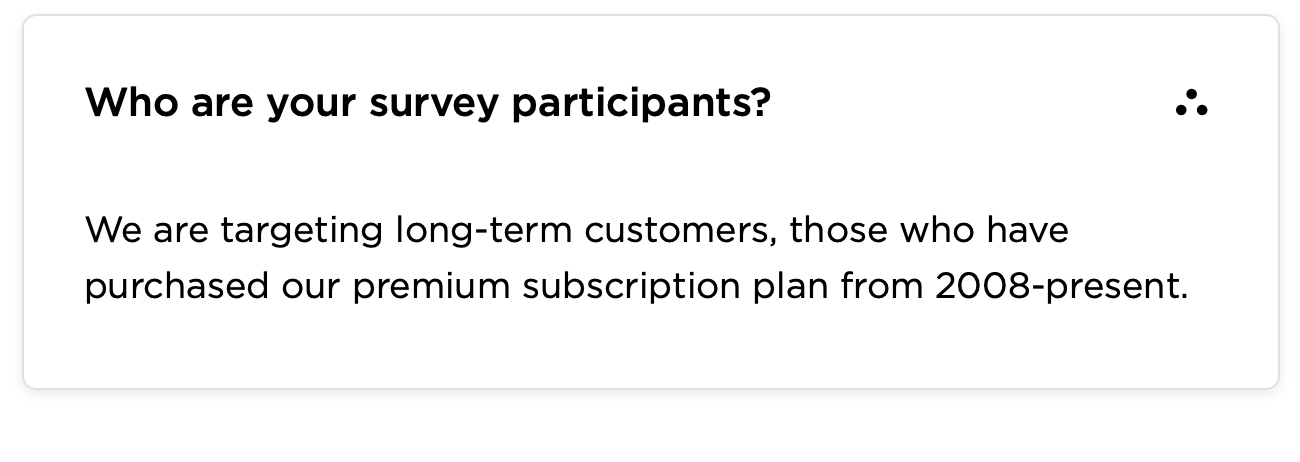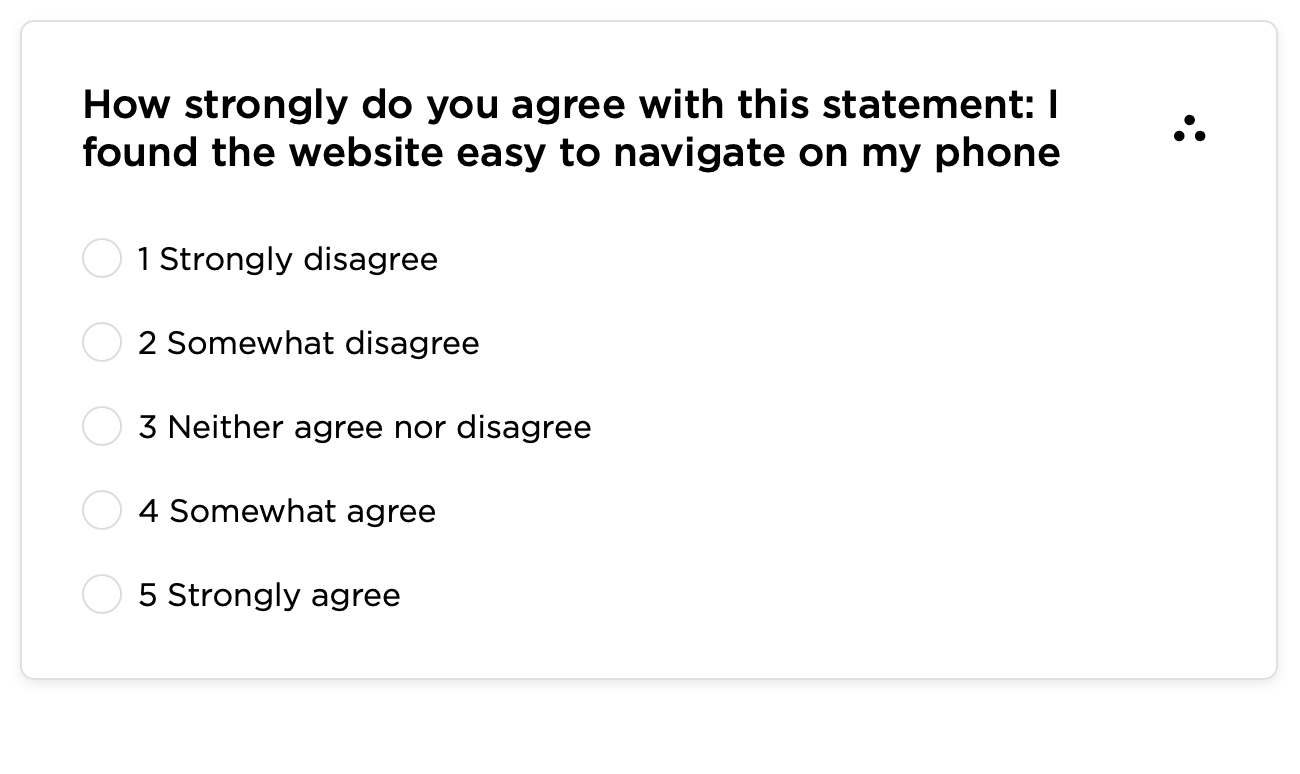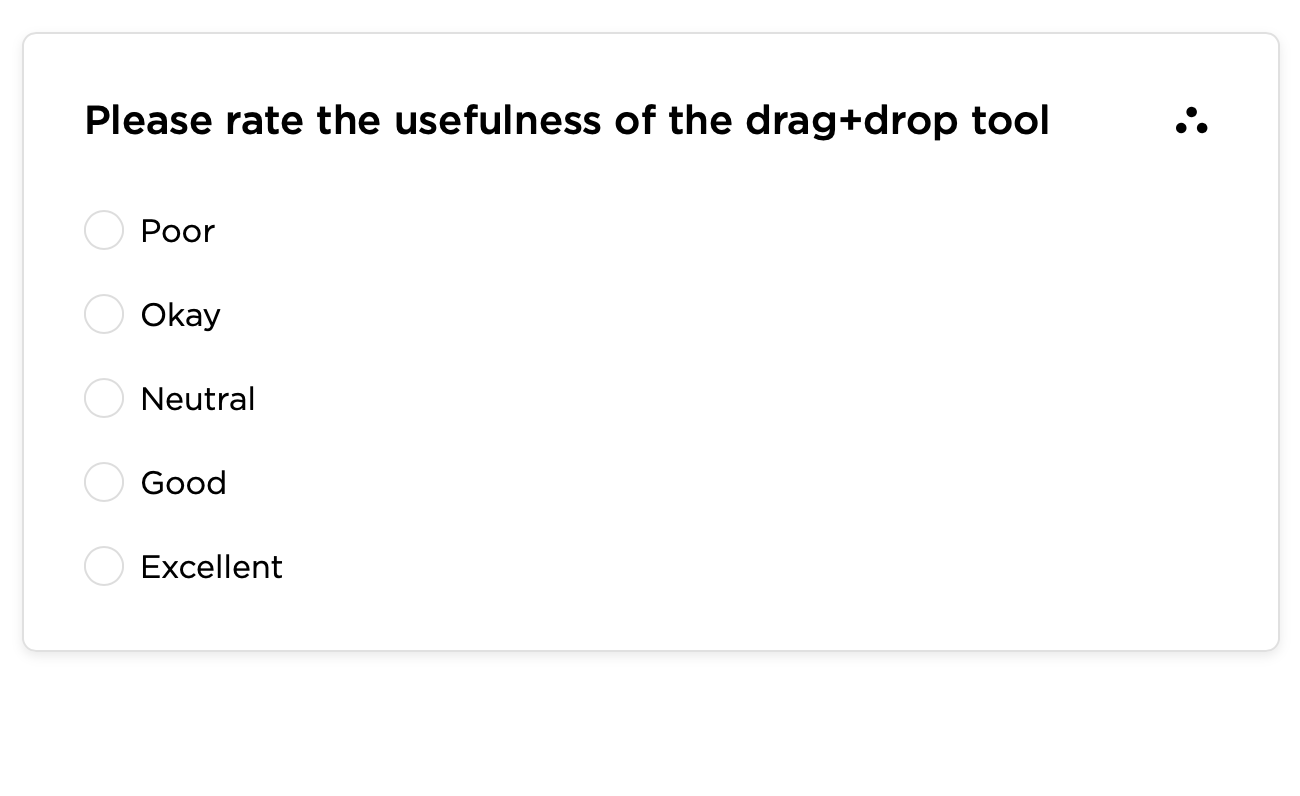How to Write a Rocking Customer Satisfaction Survey

Good ol’ customer satisfaction surveys. We all know them, we’ve all done them, we’ve all abandoned them. Or so we thought.
What we don’t always realize is that these sorts of surveys come up all the time, and we unknowingly, but willingly, participate in them.
Did you enjoy your Uber ride? Rate your driver five stars! How did you like this Netflix series? Thumbs up or down! How was the quality of your FaceTime call? Let us know in the App Store!
In this post, we’ll look at everything survey-related, from defining certain keywords to formulating your own feedback questions. It’s the total comprehensive guide to help you write a rocking customer satisfaction survey. Let’s get this show on the road!
The Three Genres of Customer Satisfaction Surveys
A customer satisfaction survey is a list of questions that help you better understand client sentiment on your product or service. There are three dominant types of customer satisfaction surveys that businesses tend to use, including a Customer Effort Score (CES), Net Promoter Score (NPS), and Customer Satisfaction Score (CSAT).
A CES is when a customer ranks their experience on a 1-7 scale ranging from ‘very difficult’ to ‘very easy.’ The higher a customer rates on this 7-point scale, the more satisfied they are perceived to be.
A NPS measures customer experience by asking how likely a client is to recommend their product or service to someone else, based on a scale from 0-10. Depending on their answer, they can either be a detractor (a score ≤ 6), a passive (a score of 7 or 8), or a promoter (≥9). Based on the comparisons of these participants, a company can tell how satisfied their customers are.
A CSAT asks a simple question with a binary response. Usually these questions are short and sweet, utilizing rating scales like smiley faces, stars, thumbs up or down, and multiple choice options. With these scores a company can determine imitate problems with their product or service.
Regardless of the type, all customer satisfaction surveys try to figure out if customers are pleased with a service, content with a brand, or loyal to a company. All very essential to business growth and success!
Why Customer Satisfaction Surveys are Key
Customer satisfaction surveys are valuable because you can gauge how your clients feel about your service. And depending on what they say, you can take all the necessary steps to make your service better to either reach their standards or even exceed their expectations.
In a competitive market, customer contentment is an essential component of a profitable business. Survey Monkey concluded that brands who measure customer satisfaction are “33% more likely to describe themselves as successful than those who don’t.” This implies that feedback forms give you insights to make better decisions regarding your company or service.
For example, maybe you find out that your website is confusing and difficult to navigate. If you make a change in website design, you are supporting a positive experience for your customers and establishing a sense of trust and loyalty for your brand. This all contributes to your business success.
So when it comes to your time and resources, it makes sense to focus on your existing customers. It is in your best interest to keep them happy in order to maintain and grow your business. Here are the facts!
- According to Harvard Business Review, companies that aim to preserve loyalty and a positive customer relationship “grow revenues roughly 2.5 times as fast as their industry peers.”
- Another study by Harvard Business Review found that “increasing customer retention rates by 5% increases profits by 25% to 95%.”
- Forbes published an article stating that businesses are 60 to 70% more likely to profit from existing clients in comparison to the 5 to 20% from new clients.
The logic behind these findings is that loyal customers are your brand ambassadors. If they are pleased with your services, they will likely return themselves or even recommend your business to others in the industry.
Okay, we get it. Customer retention is key. So how do I write my own feedback survey?
Compose Your Own Customer Satisfaction Survey
Now that we have the basics out of the way, we can start the planning process: what are your overarching goals, who will participate in your survey, and when will you send your survey out? If you answer these three questions from the get-go, writing your own feedback form will be a breeze.
1. Define your goal
Since customer satisfaction surveys are typically brief, between 1-10 questions, it’s essential to establish which topic will be your main focus.
Are you interested in product functionality? System bugs? Or even the quality of your customer service team? If needed, you can go back to the three main types of feedback forms, NPS, CES, or CSAT for inspiration!

Knowing your goals seems like an obvious first step, but sometimes it’s easy to wander from your initial survey intentions. By deciding your objectives from the beginning (maybe even writing them out!), you can ask questions that are useful for your research needs.
2. Choose your Participants
Surveys would be totally inadequate without accounting for the participants! The best feedback forms take into account their target population. That could be new customers, current customers, or those who use a special tool or service.
Don’t worry about creating a survey that appeals to everyone. If you include too many different participants, your survey might have inconclusive results or skewed data. And anyways, you’ll have many opportunities to send more forms out!

If you choose your participants wisely, you can better tailor your survey to this population, for the most accurate data!
3. Decide when your survey will be sent out
Another element to keep in mind is your survey timeline. Send it too early and your participant possibly didn’t have enough time to assess your service. Or send it too late and they might have forgotten their experience with your product. Timing can be crucial to your survey results.

There are many different timing strategies depending on your type of survey. If you want to better your onboarding process, you might send a customer satisfaction form halfway throughout. Or maybe you switch up your survey questions every year and you decide to send it out accordingly. Either way, make sure you have a clear plan of action when you distribute your survey.
Types of Questions
It turns out that how you ask a question can be just as tricky as thinking one up.
And not to get held up in the technicalities of data science, but how you pose a question greatly affects the quality of your research and the accuracy of your feedback results.
But when broken down into a few basic parts, creating survey questions can be easy!
1. Multiple choice questions
Oh the beloved multiple choice question. It’s the question type where a respondent chooses one or more items from a limited list of options.
There are two types, single and multi select. Normally these types of questions have a high response rate because they have fast processing times. This means that you can incorporate more questions into your survey without tagging on more time for the respondent.
2. Rating Scale
A rating scale, or adjustable sliders as we like to call them, is a close sister to the multiple choice question. It asks the respondent to rate their feedback on a numerical scale. In most surveys, it’s used to quantify subjective data, like feelings, satisfaction, likelihood, loyalty, etc.
Some common examples are

Or

3. Binary Scale Questions
The classic yes or no questions, the Netflix thumbs up or down. This gives the respondent two possible answers, for quick responses. The benefit to this type of question is that it limits error due to qualitative answers. Meaning that someone could rate their satisfaction towards a product at 3, while someone else might feel like it’s a 6. Binary questions reduce this ambiguity.
4. Open Ended Questions
Open ended questions give the respondent the opportunity to write out their thoughts, concerns, ideas, options, etc. This is a great way to get some more feedback on your product or service, but make sure you don’t add too many of these because they tend to have a lower response rate!
Tell us a little more about your experience with xyz in the text box below.
The beauty in creating your own survey, is that it’s totally customizable to your customers, product, and brand. You can use the question types that best align with your goals.
But if you’re having a hard time coming up with your own customer satisfaction survey, Collato created a series of inputs to make the process effortless. We even have a totally editable template as well!
Common Clams! A Few Mistakes to Watch Out for
So now that you know what types of questions to consider, make sure you’re asking them in a clear and meaningful way!
How many times have you abandoned a feedback form due to lengthy and confusing questions, or just badly written surveys in general? Too many. When writing your own customer satisfaction survey, take into account these three common mistakes so that you always hit the beat.
1. Double Barreled Questions
Double barreled questions are questions that contain two separate issues, but only have one answer. They are also commonly referred to as a ‘compound question,’ a ‘double-directed question,’ or ‘two-part question.’
Did you find the timeline tool functional and helpful?
The question asks two separate things: 1) Is the timeline functional? and 2) Is the timeline helpful? Although ‘functional’ and ‘helpful’ both have positive meanings, it doesn't mean they are interchangeable adjectives.
Maybe the client found the timeline tool functional because it technically works, but didn’t find it helpful because they didn’t use it often. In a double barreled question, there isn’t an opportunity to state this.
Make sure you’re asking just one question at a time!
2. It’s Too Long
This isn’t an interrogation! Although it’s easy to fall into the trap of ‘ask every question we can while we can,’ you should keep your survey brief. If too long, the customer might lose interest or run out of time, leaving you with a deserted form and no feedback at all.
Ideally a survey should be between 1-10 questions. We know, that’s so short! But listen, people don’t want to spend 45 minutes filling out a survey. Shorter surveys receive the highest completion rates, which in the end, is your ultimate goal.
And don’t worry, you can also send follow-up forms or change your survey questions regularity to get more information!
3. Complicated Questions
The best way to discourage a customer from participating in your survey is to write long and confusing questions. If your customer has to re-read the question multiple times, it needs to be rephrased. Focus on writing questions that can be answered quickly and easily.
How responsive was our company in answering your emails?
vs.
If you used our website ‘contact us’ link or emailed us directly, did our team get back to you in a timely manner?
Essentially these two questions ask the same thing, but the first phrasing of the question is easier to understand. With direct and well-worded questions, the probability of clients partaking in your surveys increases significantly.
Sit Back and Take a Breath-mark
After reading about all the question types, you might feel a little intimidated to write your own. Don’t panic, we’ve compiled a list of questions to help get you started.
General questions
- Where did you hear of us?
- What is your greatest concern about our product/service?
- How can we improve your experience?
- Do you have any suggestions or feedback for us?
Product questions
- Please rate your experience with [service or tool]
- How well does our product meet your expectations?
- If you could change one thing about our product, what would it be?
- How often do you use our product?
Customer service questions
- How would you rate the quality of your customer service experience?
- How responsive was our company in answering your emails?
- How easy is it to get a hold of our service team?
- Were you able to easily find information on our website?
Retention questions
- How likely are you to use our services again?
- Would you recommend our product to friends and colleagues?
- Compared to similar services, is our product quality better, worse, or the same?
- If a colleague asked about our service, how would you respond?
The Coda
Phew, we’ve covered a lot of ground; the different types of customer satisfaction surveys, why client input is crucial to business success, how to tackle creating your own feedback forms, and even what type of questions to ask (or not ask!).
While writing a survey is sometimes challenging, it’s definitely worth it in the end. By taking the process step-by-step, you’ll have a beautifully written customer feedback form in no time!
If you’re looking for more help, then head on over to Collato where we have an assortment of templates you can choose from!
🍦 Related topics you may be interested in:
1. Never Stress Over Document Reviews Again
